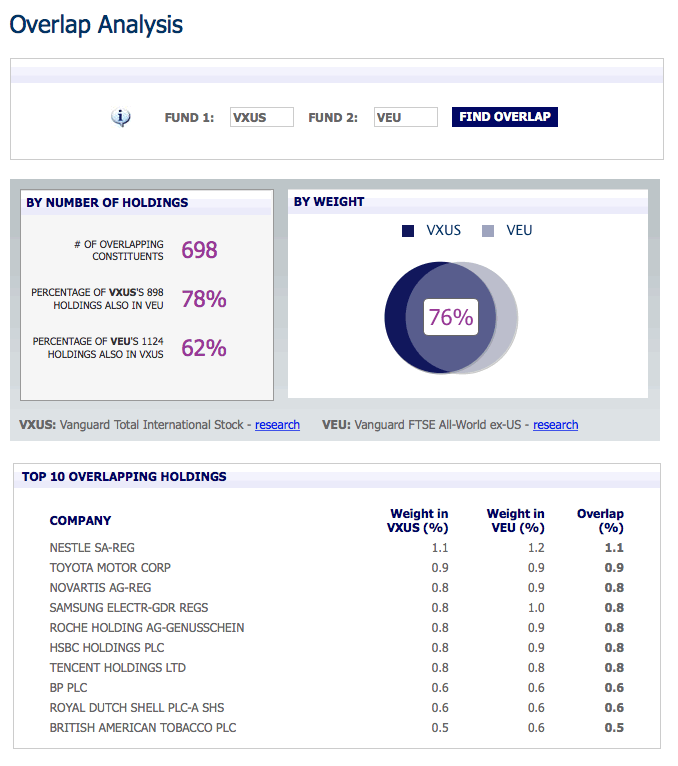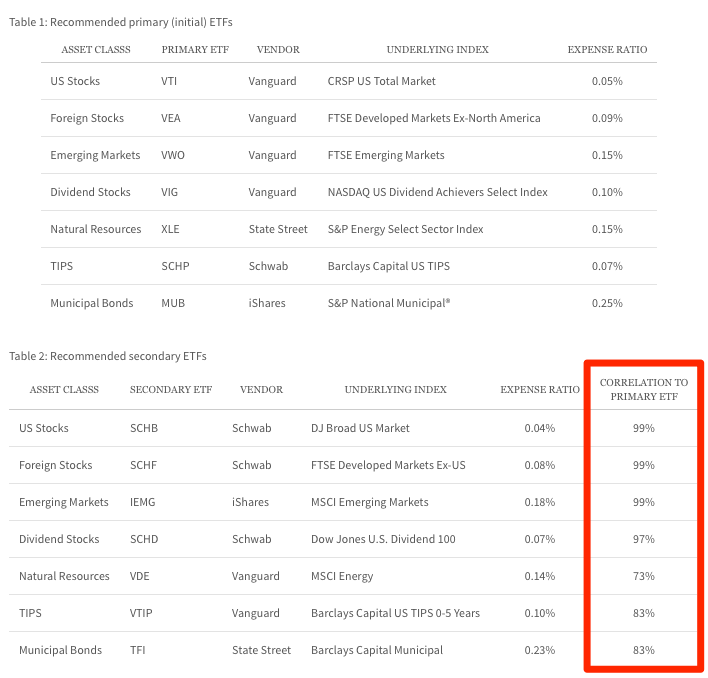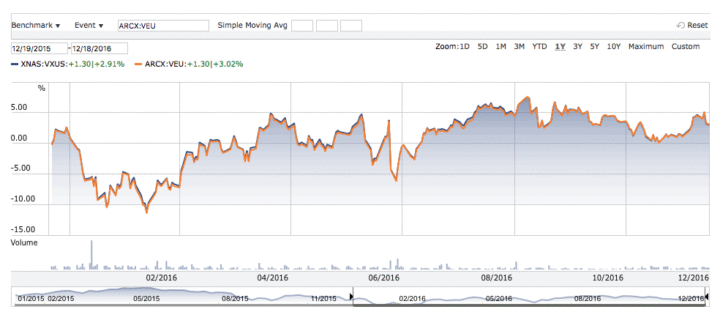 Tax-loss harvesting (TLH) is a common practice used to improve after-tax returns by realizing losses to either offset realized capital gains or to defer capital gains into the future. Many robo-advisors including Betterment and Wealthfront offer automated tax-loss harvesting as a feature. As nearly all of them hold ETFs, they accomplish this by selling the primary ETF for each asset class and replacing it temporarily with an alternative, secondary ETF. DIY investors can perform a similar maneuver as well.
Tax-loss harvesting (TLH) is a common practice used to improve after-tax returns by realizing losses to either offset realized capital gains or to defer capital gains into the future. Many robo-advisors including Betterment and Wealthfront offer automated tax-loss harvesting as a feature. As nearly all of them hold ETFs, they accomplish this by selling the primary ETF for each asset class and replacing it temporarily with an alternative, secondary ETF. DIY investors can perform a similar maneuver as well.
The IRS wash sale rule states that you can’t deduct a loss by selling a security and immediately replacing it with something “substantially identical”. Instead, harvesters buy an ETF that is slightly different. It’s a grey area, as there is no solid definition of what “substantially identical” means. However, this recent Barron’s article (paywall, use Google News) offered up a rough rule of thumb that I hadn’t seen before (bolding mine):
Although the wash-sale rule remains ambiguous, there may be an alternative standard that investors can use for guidance. In the 1980s, the IRS created the “straddle rules” to address a loophole in hedged long-short portfolios. For tax-loss purposes, the portfolios on the long side couldn’t be “substantially similar” to those on the short, which the IRS defined as having over 70% overlap. “Some people use the straddle-rules definition as a surrogate to apply to the wash-sale rule,” says Eric Fox, a principal at Deloitte Tax. “If two ETFs don’t have more than 70% overlap and they’re not substantially similar, how could they ever be considered substantially identical?” That should give loss harvesters some confidence.
I was surprised by the conservativeness of this rule of thumb. Most of the TLH articles I have read by both human and software-based advisors implement more aggressive strategies than the 70% maximum overlap suggested above. A traditional advisor quoted in the Barron’s article admitted swapping between the Vanguard Total International Stock ETF (VXUS) and the Vanguard FTSE All-World ex-US ETF (VEU). VXUS and VEU have a 76% overlap by weight, according to this ETFResearchCenter.com Overlap Tool:

Perhaps more importantly, these two ETFs have a near 100% performance correlation. Here’s a chart of the two ETFs over the last 12 months, per Morningstar (click to enlarge):
Meanwhile, this Wealthfront whitepaper shows their ETF tax-loss pairings and their correlations. Out of the 7 pairs, 4 have correlations of 97%+ and all of them are over 70%.

Commentary. There are few firm answers here. If robo-advisors marketing aggressive ETF tax-loss harvesting gather a lot of assets, I suspect the IRS will eventually provide additional guidance. I imagine the worst-case scenario as the IRS classifying past trades as violating the wash sale rule, nullifying your tax losses and possibly imposing additional penalties. I guess current practitioners don’t see a big risk of that happening. They essentially see a nearly free lunch by substituting these similar ETFs. Still, when you market something publicly as 99% correlated, aren’t you basically admitting that they are “substantially identical”?

 The Best Credit Card Bonus Offers – March 2024
The Best Credit Card Bonus Offers – March 2024 Big List of Free Stocks from Brokerage Apps
Big List of Free Stocks from Brokerage Apps Best Interest Rates on Cash - March 2024
Best Interest Rates on Cash - March 2024 Free Credit Scores x 3 + Free Credit Monitoring
Free Credit Scores x 3 + Free Credit Monitoring Best No Fee 0% APR Balance Transfer Offers
Best No Fee 0% APR Balance Transfer Offers Little-Known Cellular Data Plans That Can Save Big Money
Little-Known Cellular Data Plans That Can Save Big Money How To Haggle Your Cable or Direct TV Bill
How To Haggle Your Cable or Direct TV Bill Big List of Free Consumer Data Reports (Credit, Rent, Work)
Big List of Free Consumer Data Reports (Credit, Rent, Work)
The words similar and identical have vastly different meanings, so I would agree that a max 70% overlap is a good “safe harbor”, but that it is not a limit.
First, if one of the funds is actively managed, I think that would debunk a substantially identical claim on the fund, because the fund manager could drift or change the basket at any time. Also, the fund manager would be offended by the very idea that his fund is the same as any other fund.
Second, the 99% correlation approach is not appropriate, because correlations at the 90%+ level are generally not constant over time unless the two funds have the same underlying composition.
If the two funds are passive and have a 99% correlation since inception, then perhaps the IRS could claim they are substantially identical, but even then, a strong counterargument would exist if they are targeting different indices (for example, the entire NASDAQ vs NASDAQ 100), and the correlation is happenstance, unless they have almost the same underlying composition.
If there is the same underlying composition, it sounds like they are substantially identical.
If we have two ETF’s that have the same underlying composition then the IRS would be on strong grounds to claim they are substantially identical: an ETF market maker could convert ETF 1 to the underlying basket and convert that basket into ETF 2.
Very interesting article. Even if the IRS provides additional guidance, monitoring wash sales seems like an impossible task. Sizeable index funds within the same asset classes are always going to be highly correlated, even if the holdings within it differ.